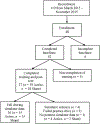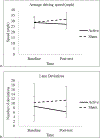A pilot investigation on the effects of combination transcranial direct current stimulation and speed of processing cognitive remediation therapy on simulated driving behavior in older adults with HIV
- PMID: 31354384
- PMCID: PMC6660181
- DOI: 10.1016/j.trf.2018.08.002
A pilot investigation on the effects of combination transcranial direct current stimulation and speed of processing cognitive remediation therapy on simulated driving behavior in older adults with HIV
Abstract
Cognitive impairments seen in people living with HIV (PLWH) are associated with difficulties in everyday functioning, specifically driving. This study utilized speed of processing cognitive remediation therapy (SOP-CRT) with transcranial direct current stimulation (tDCS) to gauge the feasibility and impact on simulated driving. Thirty PLWH (M age = 54.53, SD = 3.33) were randomly assigned to either: sham tDCS SOP-CRT or active tDCS SOP-CRT. Seven indicators of simulated driving performance and safety were obtained. Repeated measures ANOVAs controlling for driver's license status (valid and current license or expired/no license) revealed a large training effect on average driving speed. Participants who received active tDCS SOP-CRT showed a slower average driving speed (p = 0.020, d = 0.972) than those who received sham tDCS SOP-CRT. Non-significant small-to-medium effects were seen for driving violations, collisions, variability in lane positioning, and lane deviations. Combination tDCS SOP-CRT was found to increase indices of cautionary simulated driving behavior. Findings reveal a potential avenue of intervention and rehabilitation for improving driving safety among vulnerable at-risk populations, such as those aging with chronic disease.
Keywords: Brain simulation; HIV/AIDS; cognitive remediation therapy; driving; neuromodulation; tDCS.
Figures
Similar articles
-
Effect of transcranial direct current stimulation combined with cognitive training on cognitive functioning in older adults with HIV: A pilot study.Appl Neuropsychol Adult. 2019 Jan-Feb;26(1):36-47. doi: 10.1080/23279095.2017.1357037. Epub 2017 Oct 11. Appl Neuropsychol Adult. 2019. PMID: 29020472 Free PMC article. Clinical Trial.
-
Effects of speed of processing training and transcranial direct current stimulation on global sleep quality and speed of processing in older adults with and without HIV: A pilot study.Appl Neuropsychol Adult. 2020 May-Jun;27(3):267-278. doi: 10.1080/23279095.2018.1534736. Epub 2019 Jan 17. Appl Neuropsychol Adult. 2020. PMID: 30652949 Free PMC article. Clinical Trial.
-
A pilot study of cognitive training with and without transcranial direct current stimulation to improve cognition in older persons with HIV-related cognitive impairment.Neuropsychiatr Dis Treat. 2016 Oct 25;12:2745-2754. doi: 10.2147/NDT.S120282. eCollection 2016. Neuropsychiatr Dis Treat. 2016. PMID: 27822047 Free PMC article.
-
Cognitive effects of transcranial direct current stimulation treatment in patients with major depressive disorder: An individual patient data meta-analysis of randomised, sham-controlled trials.Neurosci Biobehav Rev. 2018 Jul;90:137-145. doi: 10.1016/j.neubiorev.2018.04.008. Epub 2018 Apr 13. Neurosci Biobehav Rev. 2018. PMID: 29660416 Review.
-
Neuromodulation as a cognitive enhancement strategy in healthy older adults: promises and pitfalls.Neuropsychol Dev Cogn B Aging Neuropsychol Cogn. 2017 Mar;24(2):158-185. doi: 10.1080/13825585.2016.1176986. Epub 2016 Apr 28. Neuropsychol Dev Cogn B Aging Neuropsychol Cogn. 2017. PMID: 27123674 Review.
Cited by
-
Application of Diffusion Tensor Imaging (DTI) in the Diagnosis of HIV-Associated Neurocognitive Disorder (HAND): A Meta-Analysis and a System Review.Front Neurol. 2022 Jul 7;13:898191. doi: 10.3389/fneur.2022.898191. eCollection 2022. Front Neurol. 2022. PMID: 35873786 Free PMC article.
-
Cingulate transcranial direct current stimulation in adults with HIV.PLoS One. 2022 Jun 3;17(6):e0269491. doi: 10.1371/journal.pone.0269491. eCollection 2022. PLoS One. 2022. PMID: 35658059 Free PMC article. Clinical Trial.
-
Video feedback intervention for cognitively impaired older drivers: A randomized clinical trial.Alzheimers Dement (N Y). 2021 Mar 3;7(1):e12140. doi: 10.1002/trc2.12140. eCollection 2021. Alzheimers Dement (N Y). 2021. PMID: 33718583 Free PMC article.
-
Cognitive and Neurologic Rehabilitation Strategies for Central Nervous System HIV Infection.Curr HIV/AIDS Rep. 2020 Oct;17(5):514-521. doi: 10.1007/s11904-020-00515-0. Curr HIV/AIDS Rep. 2020. PMID: 32844275 Free PMC article. Review.
-
Evaluation of Computerized Cognitive Training and Cognitive and Daily Function in Patients Living With HIV: A Meta-analysis.JAMA Netw Open. 2022 Mar 1;5(3):e220970. doi: 10.1001/jamanetworkopen.2022.0970. JAMA Netw Open. 2022. PMID: 35238931 Free PMC article.
References
-
- Ahn H, Woods AJ, Kunik ME, Bhattacharjee A, Chen Z, Choi E, & Fillingim RB (2017). Efficacy of transcranial direct current stimulation over primary motor cortex (anode) and contralateral supraorbital area (cathode) on clinical pain severity and mobility performance in persons with knee osteoarthritis: An experimenter- and participant-blinded, randomized, sham-controlled pilot clinical study. Brain Stimulation, 10(5), 902–909. doi: 10.1016/j.brs.2017.05.007 - DOI - PMC - PubMed
-
- Alabama Division of STD Prevention and Control. (2014). State of Alabama HIV Surveillance 2014 Annual Report Montgomery, AL: Alabama Department of Public Health.
-
- Ball KK, Berch DB, Helmers KF, Jobe JB, Leveck MD, Marsiske M, . . . Willis SL (2002). Effects of cognitive training interventions with older adults: A randomized controlled trial. JAMA: The Journal of the American Medical Association, 288(18), 2271–2281. doi: 10.1001/jama.288.18.2271 - DOI - PMC - PubMed
Grants and funding
LinkOut - more resources
Full Text Sources
Research Materials


